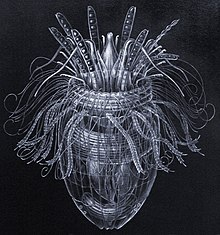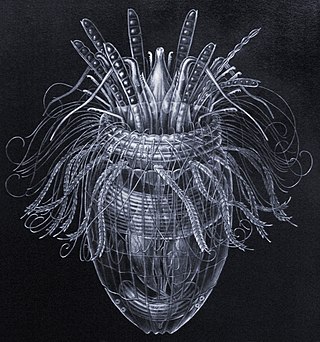
Loricifera is a phylum of very small to microscopic marine cycloneuralian sediment-dwelling animals with 43 described species. and approximately 100 more that have been collected and not yet described. Their sizes range from 100 μm to ca. 1 mm.
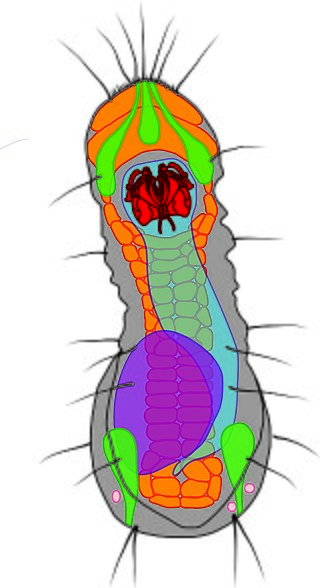
Limnognathia maerski is a microscopic acoelomate freshwater animal, discovered living in warm springs on Disko Island, Greenland, in 1994. Since then, it has also been found on the Crozet Islands of Antarctica as well as in the British Isles, suggesting a worldwide distribution, although there are likely different species yet to be described.
Reinhardt Møbjerg Kristensen is a Danish invertebrate biologist, noted for the discovery of three new phyla of microscopic animals: the Loricifera in 1983, the Cycliophora in 1995, and the Micrognathozoa in 2000. He is also considered one of the world's leading experts on tardigrades. His recent field of work revolves mostly around arctic biology.
Palaephatoidea is a superfamily of insects in the order Lepidoptera with a single family, Palaephatidae with seven known genera. These "Gondwanaland moths" exhibit a disjunct distribution occurring mainly in South America, with four species in eastern Australia and Tasmania and one in South Africa. The larvae spin together leaves of Proteaceae (Ptyssoptera) or Verbenaceae (Azaleodes) . Palaephatoidea, a typical monotrysian group, is one two main candidates as the sister group of most of the Lepidoptera, the Ditrysia.

Scalidophora is a group of marine pseudocoelomate protostomes that was proposed on morphological grounds to unite three phyla: the Kinorhyncha, the Priapulida and the Loricifera. The three phyla have four characters in common — chitinous cuticle that is moulted, rings of scalids on the introvert, flosculi, and two rings of introvert retracts. The introvert and abdomen are separated by a distinct neck region in all groups, but in adult macroscopic priapulids it becomes rudimentary in Priapulus and is completely absent in Halicryptus. However, the monophyly of the Scalidophora was not supported by two molecular studies, where the position of the Loricifera was uncertain or as sister to the Panarthropoda. Both studies supported a reduced Scalidophora comprising the Kinorhyncha and Priapulida as sister phyla. Their closest relatives are the Panarthropoda, Nematoda and Nematomorpha; thus, they are placed in the group Ecdysozoa.

Pharyngeal teeth are teeth in the pharyngeal arch of the throat of cyprinids, suckers, and a number of other fish species otherwise lacking teeth.

In zoology, deep-sea gigantism or abyssal gigantism is the tendency for species of deep-sea dwelling animals to be larger than their shallower-water relatives across a large taxonomic range. Proposed explanations for this type of gigantism include colder temperature, food scarcity, reduced predation pressure and increased dissolved oxygen concentrations in the deep sea. The inaccessibility of abyssal habitats has hindered the study of this topic.
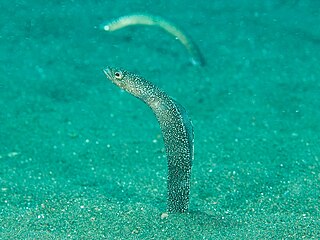
The enigma garden eel is a species of eel in the conger/garden eel family Congridae.

Pliciloricus is a genus of marine organisms Pliciloricidae family, the phylum Loricifera described by Higgins & Kristensen, 1986.

Pliciloricidae are a family of marine organisms in the phylum Loricifera. It contains 23 species in 4 genera.
Rugiloricus is a genus of marine organisms of the phylum Loricifera and the family Pliciloricidae, described by Higgins & Kristensen in 1986.
Rugiloricus cauliculus is a species of marine animal of the phylum Loricifera and the family Pliciloricidae. The species was described by Higgins & Kristensen in 1986, however other sources such as OBIS indicate that discovery of the species occurred on 19 November 1983.

Titaniloricus is a genus of small marine animal in the phylum Loricifera. It contains a single species, Titaniloricus inexpectatovus, described by Gunnar Gad in 2005. It has been collected from the abyssal plain in Angolan waters of the Atlantic Ocean.
Pliciloricus dubius is a marine Loriciferan species of genus Pliciloricus described by Higgins & Kristensen 1986.
Robert Price Higgins was an American systematic invertebrate zoologist and ecologist, who specialized in the unusual taxa of kinorhynchs and tardigrades.
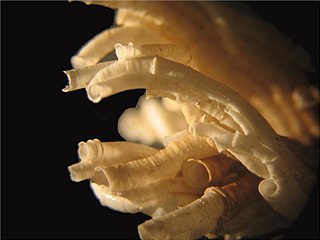
Ficopomatus enigmaticus, commonly known as the Australian tubeworm, is a species of serpulid tubeworms. Their true native range is unknown, but they probably originated in the Southern Hemisphere, perhaps from the Indian Ocean and the coastal waters of Australia. Today they have a cosmopolitan distribution, having been introduced to shallow waters worldwide. The Australian tubeworm is an invasive species that dominates and alters habitats, reduces water quality, depletes resources, and causes biofouling.
Urnaloricus is a genus of loricifera; it is distinct enough to belong to its own family, Urnaloricidae. Loricifera are phylum that are animals that live in marine area only, and very small in size. The Urnaloricus was found Southwest in the Faroe Islands, North Atlantic. It was the thirty-eighth loriciferan species found. One part of the life cycle is the Higgins larva and it is introverted with eight two-segmented clavoscalids.
Jeanne Renaud-Mornant, Born Jeanne Renaud, Jeanne Renaud-Debyser before her second marriage was a French biologist specialising in meiofauna.
Bathyechiniscus tetronyx is a species of tardigrades. It is the only species of the genus Bathyechiniscus, which belongs to the family Styraconyxidae. The species and genus were named by Gotthold Steiner in 1926, for the presence of four different exposed points or hooks on each claw. The species has been found in the Davis Sea, on the eastern coast of Antarctica.
